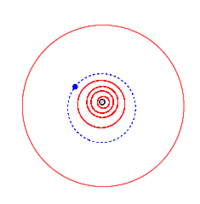(9928) 1981 WE9
(9928) 1981 WE9, provisional designation 1981 WE9, is a stony Florian asteroid from the inner regions of the asteroid belt, approximately 3 kilometers in diameter. It was discovered on 16 November 1981, by astronomers at Perth Observatory in Bickley, Australia.[2]
| Discovery [1] | |
|---|---|
| Discovered by | Perth Obs. |
| Discovery site | Perth Obs. |
| Discovery date | 16 November 1981 |
| Designations | |
| (9928) 1981 WE9 | |
| 1981 WE9 · 1971 TJ1 1993 FC43 | |
| main-belt [1][2] · Flora [3] | |
| Orbital characteristics [1] | |
| Epoch 4 September 2017 (JD 2458000.5) | |
| Uncertainty parameter 0 | |
| Observation arc | 65.74 yr (24,012 days) |
| Aphelion | 2.6101 AU |
| Perihelion | 1.8246 AU |
| 2.2174 AU | |
| Eccentricity | 0.1771 |
| 3.30 yr (1,206 days) | |
| 340.29° | |
| 0° 17m 54.6s / day | |
| Inclination | 2.8472° |
| 179.45° | |
| 176.04° | |
| Physical characteristics | |
| Dimensions | 2.441±0.327 km[4] 2.938±0.660 km[5] 3.00±0.42 km[6] 3.11 km (calculated)[3] |
| 5.547±0.005 h[7] 18.310±0.0034 h[8] 18.3980±0.0034 h[3][8] | |
| 0.24 (assumed)[3] 0.283±0.152[6] 0.3557±0.2289[5] 0.428±0.109[4] | |
| S [3] | |
| 14.4[5] · 14.60[4][6] · 14.7[1][3] | |
Orbit and classification

The stony S-type asteroid is a member of the Flora family, one of the largest groups of asteroids in the main-belt. It orbits the Sun at a distance of 1.8–2.6 AU once every 3 years and 4 months (1,206 days).
Its orbit has an eccentricity of 0.18 and an inclination of 3° with respect to the ecliptic.[1] A first precovery was taken at Palomar in 1951, extending the body's observation arc by 30 years prior to its official discovery observation at Bickley.[2]
Physical characteristics
In December 2014, astronomer Maurice Clark obtained a rotational lightcurve from photometric observations at Preston Gott Observatory. Lightcurve analysis gave an ambiguous rotation period of 18.3980 hours with a brightness variation of 0.41 magnitude, suggesting a non-spheroidal shape (U=2+). The alternative period solution is 9.14 hours with an amplitude of 0.32 magnitude.[8] The results supersede a previously obtained period of 5.547 hours (U=2).[7]
Diameter and albedo
According to the survey carried out by NASA's Wide-field Infrared Survey Explorer with its subsequent NEOWISE mission, the asteroid measures between 2.44 and 3.00 kilometers in diameter, and its surface has an albedo between 0.283 and 0.428.[4][5][6] The Collaborative Asteroid Lightcurve Link assumes an intermediate albedo of 0.24 – derived from 8 Flora, the largest member and namesake of this asteroid family – and calculates a diameter of 3.11 kilometers with an absolute magnitude of 14.7.[3]
Numbering and naming
This minor planet was numbered by the Minor Planet Center on 2 February 1999.[9] As of 2018, it has not been named.[2]
References
- "JPL Small-Body Database Browser: 9928 (1981 WE9)" (2017-05-05 last obs.). Jet Propulsion Laboratory. Retrieved 26 May 2017.
- "9928 (1981 WE9)". Minor Planet Center. Retrieved 17 March 2017.
- "LCDB Data for (9928)". Asteroid Lightcurve Database (LCDB). Retrieved 17 March 2017.
- Nugent, C. R.; Mainzer, A.; Masiero, J.; Bauer, J.; Cutri, R. M.; Grav, T.; et al. (December 2015). "NEOWISE Reactivation Mission Year One: Preliminary Asteroid Diameters and Albedos". The Astrophysical Journal. 814 (2): 13. arXiv:1509.02522. Bibcode:2015ApJ...814..117N. doi:10.1088/0004-637X/814/2/117.
- Mainzer, A.; Grav, T.; Masiero, J.; Hand, E.; Bauer, J.; Tholen, D.; et al. (November 2011). "NEOWISE Studies of Spectrophotometrically Classified Asteroids: Preliminary Results". The Astrophysical Journal. 741 (2): 25. arXiv:1109.6407. Bibcode:2011ApJ...741...90M. doi:10.1088/0004-637X/741/2/90.
- Masiero, Joseph R.; Mainzer, A. K.; Grav, T.; Bauer, J. M.; Cutri, R. M.; Nugent, C.; et al. (November 2012). "Preliminary Analysis of WISE/NEOWISE 3-Band Cryogenic and Post-cryogenic Observations of Main Belt Asteroids". The Astrophysical Journal Letters. 759 (1): 5. arXiv:1209.5794. Bibcode:2012ApJ...759L...8M. doi:10.1088/2041-8205/759/1/L8.
- Clark, Maurice (June 2008). "Asteroid Lightcurves from the Chiro Observatory". The Minor Planet Bulletin. 35 (2): 42–43. Bibcode:2008MPBu...35...42C. ISSN 1052-8091.
- Clark, Maurice (July 2015). "Asteroid Photometry from the Preston Gott Observatory". The Minor Planet Bulletin. 42 (3): 163–166. Bibcode:2015MPBu...42..163C. ISSN 1052-8091.
- "MPC/MPO/MPS Archive". Minor Planet Center. Retrieved 24 February 2018.
External links
- Asteroid Lightcurve Database (LCDB), query form (info)
- Dictionary of Minor Planet Names, Google books
- Asteroids and comets rotation curves, CdR – Observatoire de Genève, Raoul Behrend
- Discovery Circumstances: Numbered Minor Planets (5001)-(10000) – Minor Planet Center
- (9928) 1981 WE9 at the JPL Small-Body Database